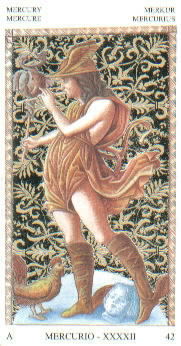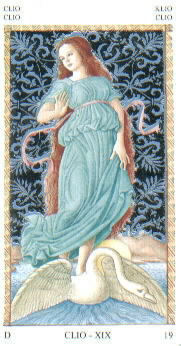|
|
 Mantegna
Tarot Mantegna
Tarot
- modern publisher: Lo Scarabeo
- first appeared: Ferrara/Venice, c. 1460
This deck is a modern artistic recreation of the Tarocchi
del Mantegna, a classic series of 15th-century Venetian
engravings depicting tarot-like subjects. There are 50
cards, divided into 5 series of 10 each (the ranks of
society, Apollo and the muses, the arts and sciences, the
virtues, and the celestial spheres). Although not a tarot
deck, it has many intriguing parallels with the tarot. The
Mantegna series clearly depicts an ordered, philosophical
system, giving an explicit logical structure to the planes
of existence. The designs were previously available only as
a collectible monochrome reproduction issued by Il
Meneghello. Although in some ways the Il Meneghello set is
more faithful to the originals, it is not actually
"authentic" either, being a reproduction of line drawings
made long ago for book illustrations, rather than
reproducing the original engravings themselves. The Lo
Scarabeo issue can be regarded as an alternative means for
modern tarot enthusiasts to become acquainted with the basic
subject matter and symbolism of the Mantegna prints.
 The
Mantegna Tarot is really quite beautiful--the effect of the
silver just doesn't come across in photos. (Each card has a
silver background decorated with a Renaissance floral
filigree design, the color of which changes according to
which of the five Mantegna series the card belongs to.)
Although this background is sometimes a bit distracting, it
lends such a look of beauty and extravagance to the deck
that one can hardly complain. The
Mantegna Tarot is really quite beautiful--the effect of the
silver just doesn't come across in photos. (Each card has a
silver background decorated with a Renaissance floral
filigree design, the color of which changes according to
which of the five Mantegna series the card belongs to.)
Although this background is sometimes a bit distracting, it
lends such a look of beauty and extravagance to the deck
that one can hardly complain.
I was very impressed with the quality of the drawings
themselves (they were done by Atanas Atanassov, who also did
the artwork on Lo Scarabeo's Visconti Tarots). The original
Mantegna prints, of course, were uncolored engravings, and
these cards do not attempt to duplicate that look.
Nevertheless, they are faithful to the original in all the
details of symbolism, pose, etc. The coloring is very
tasteful, with a lot of pastels and careful cross-hatched
shading. The coloring complements the silver backgrounds
well, and, although bright and vivid, doesn't seem gaudy or
inappropriate to the 15th-century designs.
 The
artist did not duplicate the original title lettering;
instead there is a border around each image and the card
titles and numbers are printed in modern type on the bottom
border. The top border gives a translation of the title into
four modern languages (English, German, French, and Dutch).
I would have preferred they left this off, as I think the
Italian titles present little difficulty, being often proper
names (the muses, the planets) or easily recognizable terms.
Strangely, the three "genii", Iliaco, Cosmico, and Chronico,
are translated as "Intellect", "Vital Functions", and
"Senses". These terms have no basis in the Italian titles of
the cards, and are not even warranted from the allegorical
imagery they depict. This is a minor irritant in what is
otherwise a faithful presentation of the ancient
designs. The
artist did not duplicate the original title lettering;
instead there is a border around each image and the card
titles and numbers are printed in modern type on the bottom
border. The top border gives a translation of the title into
four modern languages (English, German, French, and Dutch).
I would have preferred they left this off, as I think the
Italian titles present little difficulty, being often proper
names (the muses, the planets) or easily recognizable terms.
Strangely, the three "genii", Iliaco, Cosmico, and Chronico,
are translated as "Intellect", "Vital Functions", and
"Senses". These terms have no basis in the Italian titles of
the cards, and are not even warranted from the allegorical
imagery they depict. This is a minor irritant in what is
otherwise a faithful presentation of the ancient
designs.
 There
are only 50 cards in the Mantegna series, but the publisher
decided to fill out the package with 25 extra cards giving
divinatory meanings. Each of the extra cards shows reduced
images of two of the cards, and gives a divinatory meaning
for each, in six languages (the additional language being
Spanish). This is a creative and attractive presentation,
and probably quite helpful, as people new to the Mantegna
series can look up meanings by matching the pictures rather
than titles. Considering that 25 cards are devoted to
presenting divinatory meanings, the meanings themselves are
quite terse, being only a word or short phrase for each
card. Also, except in cases where card subject has a pretty
obvious interpretation (the virtues and planets, for
example), the divinatory meanings assigned seem rather
arbitrary. As with many of the Lo Scarabeo decks, the
keywords don't show much evidence of research into the
symbolism. If I decide to use this deck for divination, I'll
probably be working out my own meanings. The booklet that
comes with the cards repeats the divinatory meanings, gives
a bit of solid history regarding the series, and includes an
interesting, novel divination method: one basically plays a
sort of "solitaire" came with the deck, and interprets only
the cards that are still in play when you have no possible
moves left. There
are only 50 cards in the Mantegna series, but the publisher
decided to fill out the package with 25 extra cards giving
divinatory meanings. Each of the extra cards shows reduced
images of two of the cards, and gives a divinatory meaning
for each, in six languages (the additional language being
Spanish). This is a creative and attractive presentation,
and probably quite helpful, as people new to the Mantegna
series can look up meanings by matching the pictures rather
than titles. Considering that 25 cards are devoted to
presenting divinatory meanings, the meanings themselves are
quite terse, being only a word or short phrase for each
card. Also, except in cases where card subject has a pretty
obvious interpretation (the virtues and planets, for
example), the divinatory meanings assigned seem rather
arbitrary. As with many of the Lo Scarabeo decks, the
keywords don't show much evidence of research into the
symbolism. If I decide to use this deck for divination, I'll
probably be working out my own meanings. The booklet that
comes with the cards repeats the divinatory meanings, gives
a bit of solid history regarding the series, and includes an
interesting, novel divination method: one basically plays a
sort of "solitaire" came with the deck, and interprets only
the cards that are still in play when you have no possible
moves left.
The card backs are a very attractive white-on-navy
Renaissance floral design. The cards are also a good size,
just a bit larger than most of the publisher's earlier
offerings.
Despite my quibbles, I'm very happy with this deck. The
quality of the artwork and the attractive clear colors make
this deck something you actually want to look at and work
with, rather than file on a shelf. Because it is being
distributed by Llewellyn in the US, it gives American tarot
enthusiasts their first easy access to the Tarocchi del
Mantegna. Although I expect divination with this deck may
take some concerted study (and be hampered by the complete
absence of "dark" cards like the Tower and Devil), the
combination of its historical interest and strikingly
beautiful presentation is sure to make it a welcome addition
to many deck collections.
|